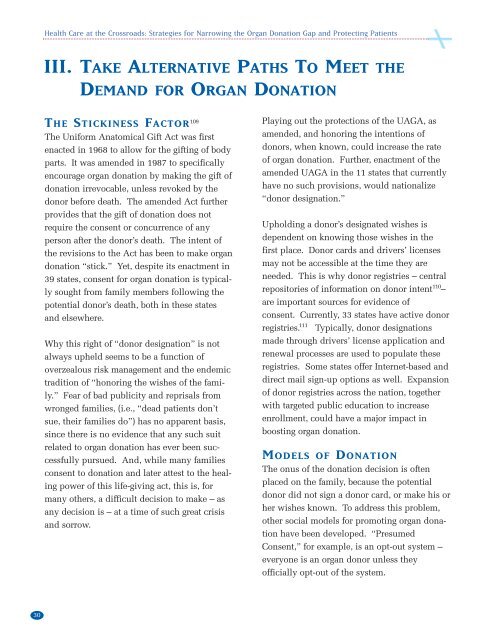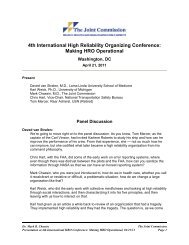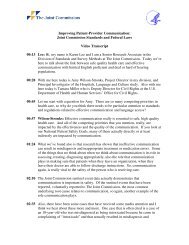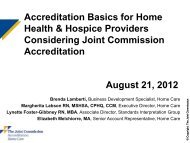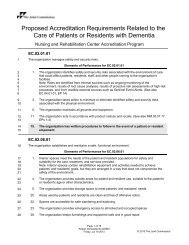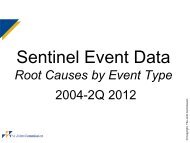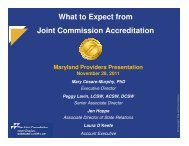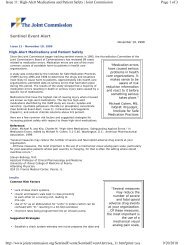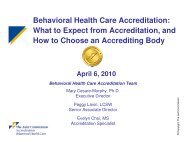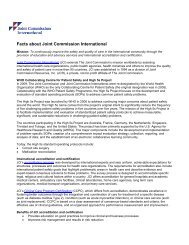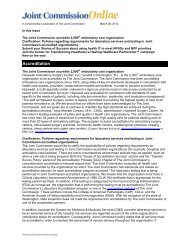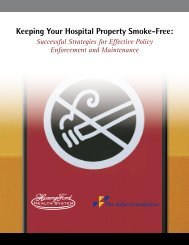Health Care at the Crossroads: Strategies for ... - Joint Commission
Health Care at the Crossroads: Strategies for ... - Joint Commission
Health Care at the Crossroads: Strategies for ... - Joint Commission
You also want an ePaper? Increase the reach of your titles
YUMPU automatically turns print PDFs into web optimized ePapers that Google loves.
<strong>Health</strong> <strong>Care</strong> <strong>at</strong> <strong>the</strong> <strong>Crossroads</strong>: Str<strong>at</strong>egies <strong>for</strong> Narrowing <strong>the</strong> Organ Don<strong>at</strong>ion Gap and Protecting P<strong>at</strong>ients<br />
III. TAKE ALTERNATIVE PATHS TO MEET THE<br />
DEMAND FOR ORGAN DONATION<br />
THE STICKINESS FACTOR 109<br />
The Uni<strong>for</strong>m An<strong>at</strong>omical Gift Act was first<br />
enacted in 1968 to allow <strong>for</strong> <strong>the</strong> gifting of body<br />
parts. It was amended in 1987 to specifically<br />
encourage organ don<strong>at</strong>ion by making <strong>the</strong> gift of<br />
don<strong>at</strong>ion irrevocable, unless revoked by <strong>the</strong><br />
donor be<strong>for</strong>e de<strong>at</strong>h. The amended Act fur<strong>the</strong>r<br />
provides th<strong>at</strong> <strong>the</strong> gift of don<strong>at</strong>ion does not<br />
require <strong>the</strong> consent or concurrence of any<br />
person after <strong>the</strong> donor’s de<strong>at</strong>h. The intent of<br />
<strong>the</strong> revisions to <strong>the</strong> Act has been to make organ<br />
don<strong>at</strong>ion “stick.” Yet, despite its enactment in<br />
39 st<strong>at</strong>es, consent <strong>for</strong> organ don<strong>at</strong>ion is typically<br />
sought from family members following <strong>the</strong><br />
potential donor’s de<strong>at</strong>h, both in <strong>the</strong>se st<strong>at</strong>es<br />
and elsewhere.<br />
Why this right of “donor design<strong>at</strong>ion” is not<br />
always upheld seems to be a function of<br />
overzealous risk management and <strong>the</strong> endemic<br />
tradition of “honoring <strong>the</strong> wishes of <strong>the</strong> family.”<br />
Fear of bad publicity and reprisals from<br />
wronged families, (i.e., “dead p<strong>at</strong>ients don’t<br />
sue, <strong>the</strong>ir families do”) has no apparent basis,<br />
since <strong>the</strong>re is no evidence th<strong>at</strong> any such suit<br />
rel<strong>at</strong>ed to organ don<strong>at</strong>ion has ever been successfully<br />
pursued. And, while many families<br />
consent to don<strong>at</strong>ion and l<strong>at</strong>er <strong>at</strong>test to <strong>the</strong> healing<br />
power of this life-giving act, this is, <strong>for</strong><br />
many o<strong>the</strong>rs, a difficult decision to make – as<br />
any decision is – <strong>at</strong> a time of such gre<strong>at</strong> crisis<br />
and sorrow.<br />
Playing out <strong>the</strong> protections of <strong>the</strong> UAGA, as<br />
amended, and honoring <strong>the</strong> intentions of<br />
donors, when known, could increase <strong>the</strong> r<strong>at</strong>e<br />
of organ don<strong>at</strong>ion. Fur<strong>the</strong>r, enactment of <strong>the</strong><br />
amended UAGA in <strong>the</strong> 11 st<strong>at</strong>es th<strong>at</strong> currently<br />
have no such provisions, would n<strong>at</strong>ionalize<br />
“donor design<strong>at</strong>ion.”<br />
Upholding a donor’s design<strong>at</strong>ed wishes is<br />
dependent on knowing those wishes in <strong>the</strong><br />
first place. Donor cards and drivers’ licenses<br />
may not be accessible <strong>at</strong> <strong>the</strong> time <strong>the</strong>y are<br />
needed. This is why donor registries – central<br />
repositories of in<strong>for</strong>m<strong>at</strong>ion on donor intent 110 –<br />
are important sources <strong>for</strong> evidence of<br />
consent. Currently, 33 st<strong>at</strong>es have active donor<br />
registries. 111 Typically, donor design<strong>at</strong>ions<br />
made through drivers’ license applic<strong>at</strong>ion and<br />
renewal processes are used to popul<strong>at</strong>e <strong>the</strong>se<br />
registries. Some st<strong>at</strong>es offer Internet-based and<br />
direct mail sign-up options as well. Expansion<br />
of donor registries across <strong>the</strong> n<strong>at</strong>ion, toge<strong>the</strong>r<br />
with targeted public educ<strong>at</strong>ion to increase<br />
enrollment, could have a major impact in<br />
boosting organ don<strong>at</strong>ion.<br />
MODELS OF DONATION<br />
The onus of <strong>the</strong> don<strong>at</strong>ion decision is often<br />
placed on <strong>the</strong> family, because <strong>the</strong> potential<br />
donor did not sign a donor card, or make his or<br />
her wishes known. To address this problem,<br />
o<strong>the</strong>r social models <strong>for</strong> promoting organ don<strong>at</strong>ion<br />
have been developed. “Presumed<br />
Consent,” <strong>for</strong> example, is an opt-out system –<br />
everyone is an organ donor unless <strong>the</strong>y<br />
officially opt-out of <strong>the</strong> system.<br />
30


